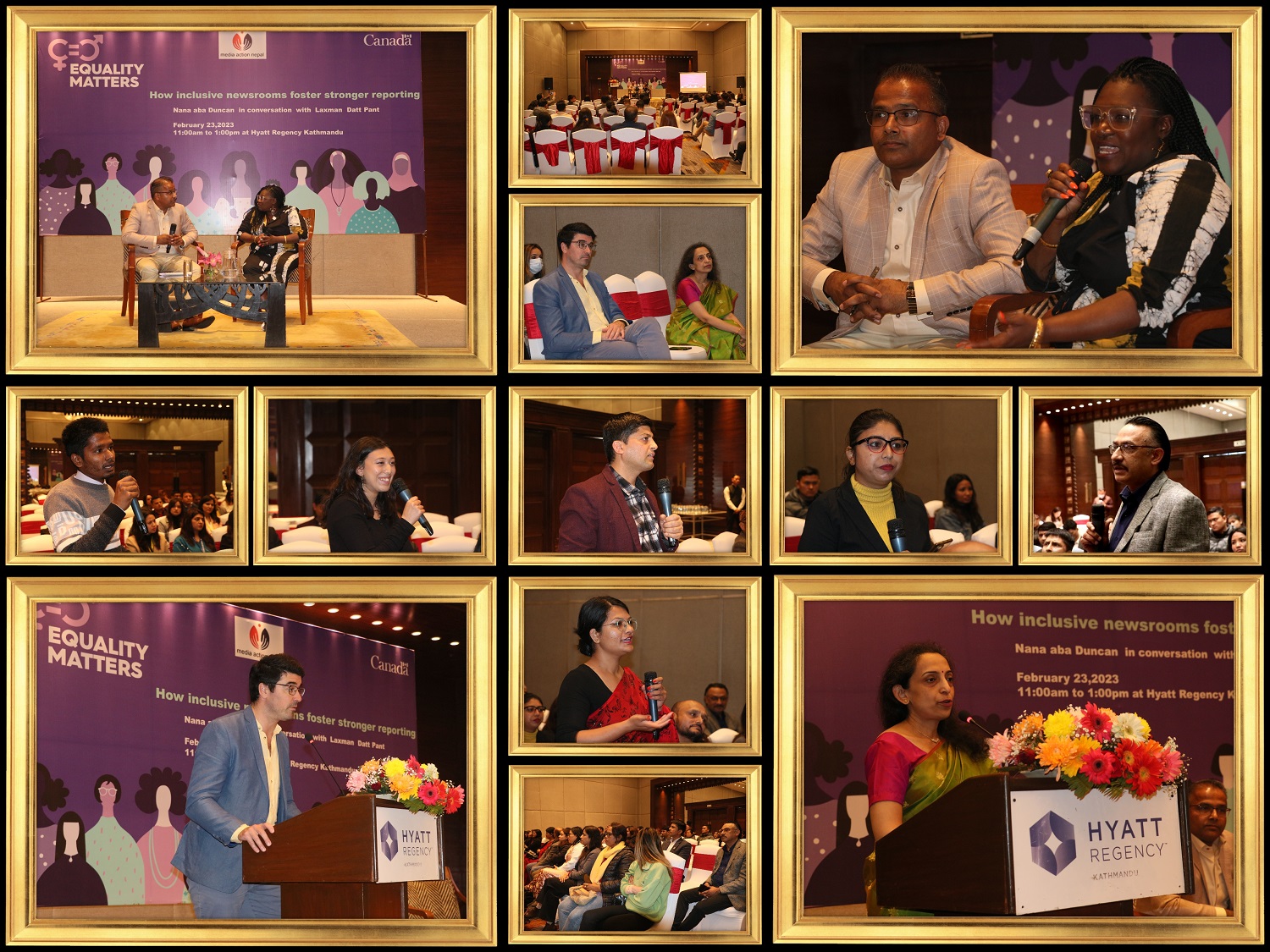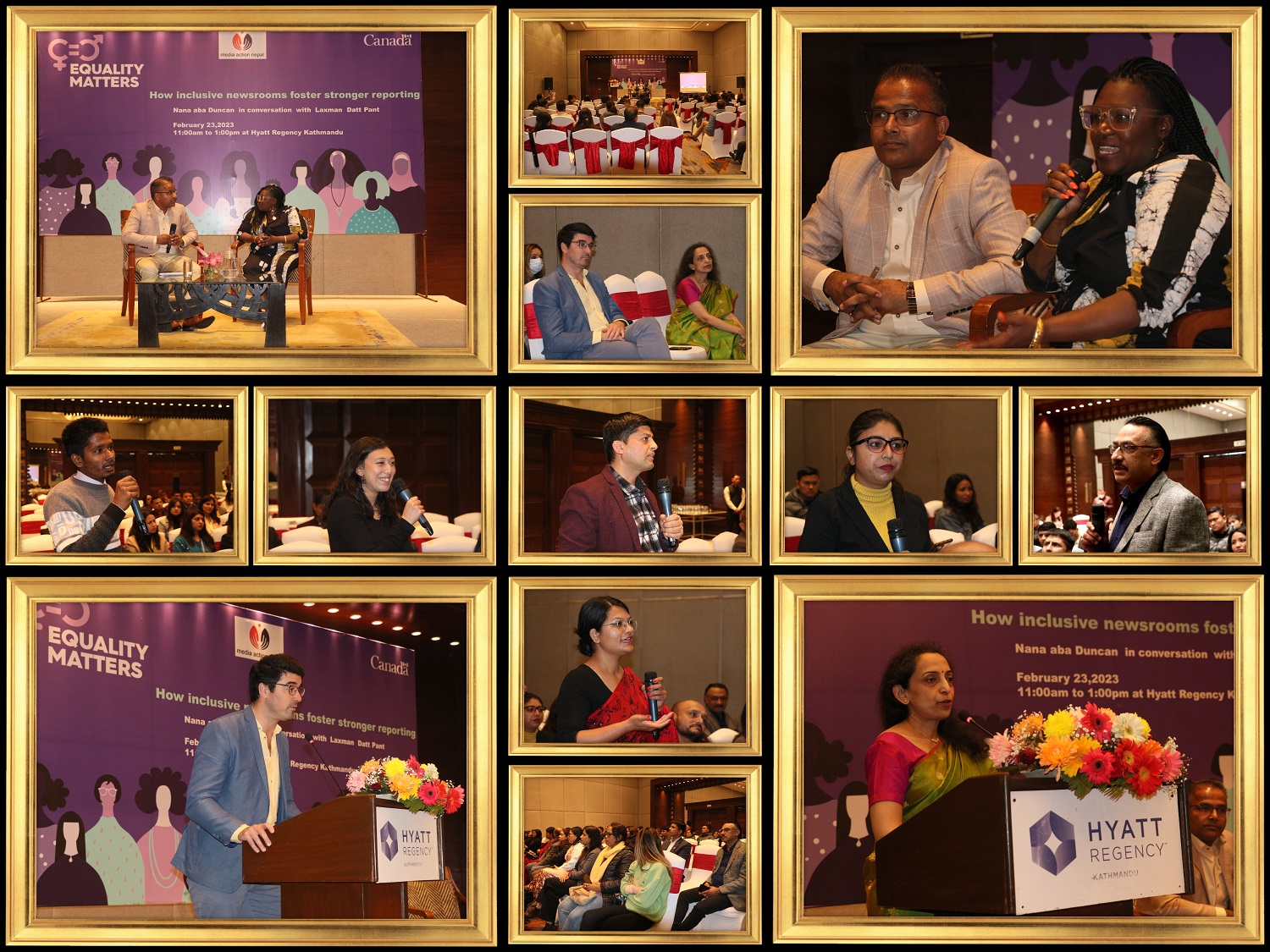
Promoting inclusive and diverse newsrooms
KATHMANDU/March 10: It is not enough to just want diversity in the newsroom. Editors and decision-makers have to take action to make that happen. Award-winning Canadian journalist and Carty Chair in Journalism, Diversity and Inclusion Studies at Carleton University’s School of Journalism and Communication Nana aba Duncan stressed this point while in dialogue with Media Action Nepal’s Chairperson Laxman Datt Pant in Kathmandu on February 23.

Speaking to an audience of media persons, advocates, students and stakeholders, Duncan built on her statement of diversity and said that it could only come with concentrated efforts. “Policies, in particular, need to be drafted,” she said, “But they also need to be implemented.”
Pushing for diversity and inclusion in the media requires a shift in culture for which, the policies for and the outlook of those at the top need to change. This change must then flow to the newsrooms and then to journalists, she emphasised, also noting the role media teachers could play in bringing this change. In her opinions, educators can and should teach their students to support different voices from different communities and enable them to be agents of inclusion when they reach the newsrooms.
Duncan’s journalism journey
The one and half hours long dialogue started with Pant acknowledging the diversity present in the room with academia, editors, reporters, researchers and advocates being represented. He asked Duncan to share her journey from active journalism to academia.
Duncan shared that she worked in journalism for 15 years but moved into academia by accident. About four years ago, when working as the host of a morning show at the Canadian Broadcasting Corporation (CBC), she got the opportunity to take a year off from CBC and be a fellow at the University of Toronto. As a part of her fellowship, she was asked to think about her future and draft a mission statement to push for inclusion in the media industry.

Exposing truth and pushing for diversity
Pant asked her what was easy: exposing truth as a journalist or pushing for diversity. Duncan shared that truth could come in many forms, it could be achieved by writing accurately on issues or it could be achieved by ensuring that voices from diverse, marginalised, communities find space in the media.
The issue of inclusion in South Asian newsrooms

Referencing Duncan’s first visit to South Asia, Pant asked her how she compared the East and West in the spaces given to woman and racialised communities in newsrooms. Duncan found that the number of women in the newsrooms of Canada may be higher than in the newsrooms of Nepal and India but their roles are limited, they are part-time and are not in leadership positions. And, to change this, requires a culture shift. It is not enough to just say that we want to change, we have to make the effort to change and take steps to change. Also, in seeking diversity, we must not pigeonhole journalists from marginalised communities. Recruiting them only to tick boxes, only giving them issues to cover from their communities or constantly perceiving and projecting their difference. This creates a gap between the journalist and their colleagues and seniors and prevents them from speaking up, presenting their perspective and bringing nuance to discussions.
Leadership in newsrooms
Pant asked why Duncan felt that journalists from marginalised communities did not get spaces in newsrooms and were given leadership positions. If this was an issue of sensitivity or needed policy interventions. Duncan answered with regard to her country Canada and said that policies needed to be created but they also needed to be enforced. Things have to change at the top from where, it must flow to the newsrooms and then to journalists. Also, media teachers have to teach their students to support different voices from different communities. They have to prepare their students to support diversity and inclusion when they migrate from the classroom to the newsroom.
What is an inclusive newsroom?
Pant asked Duncan to present what an inclusive newsroom would be. Duncan shared that it would be a newsroom that asks itself who it did not have and then, how to bring perspectives from the communities that are not present in the newsroom. And also, newsrooms need to not just report events and information but understand the context and realise where the story (they are reporting) began. When it comes to inclusion at work, we have to make sure to hire people from different communities, take steps to retain them by making sure that there are programs to support them by their peers and management.
Why is it that only women journalists cover women issues?

Duncan shared that in many cases, groups that are marginalised are the first to speak up about marginalisation. But, the role of men today is to be allies, to understand that women do not get the spaces they deserve and speak up for them – BUT NOT WITHOUT THEIR PERMISSION. Also, amplify. Women should magnify other women’s voices.
Pant observed that it is not that men in media do not talk about women’s issues. Editors go on at length about women’s issues. But what lacks is empathy. Also, we have impunity. The perpetrators of violence against women and marginalised groups are put in places of power. Also, media is more concerned about social media or outside elements challenging their supposed power than introspecting the lack of diversity and the impunity within them.
Black lives matter and MeToo movement
To Pant’s question about the changes that have been brought by the #BlackLivesMatter and #MeToo movement, Duncan answered that the movements had called on us to learn and unlearn and take heed of the situation around us. In Canada, the murder of George Floyd was a reckoning that made many people of colour in journalism recall the hurt they have had to go through because of the colour of their skin. Pant spoke about how things changed in Nepal and said that these movements created an awareness in newsrooms but could not gather momentum. He again asked if these movements enabled deprived communities to come forth and if they had created an enabling environment to prevent future discrimination and harassment.
Duncan said that it depended on the organisations and each institution dealt with it different. But, as people, these movements enabled us to stop and take a look at what was happening around us. Pant also asked about the things people say and do, knowingly or unknowingly, that is discriminatory and ways to correct the mistakes we make. Duncan put it quite simply. If apologise for our statements or actions and never make the mistake again. We do not let our emotions reach extremes and make the other person more uncomfortable.
Intersectionality in newsrooms
In a question by Hari Sharan Lamichhane, Chief- News Editor of Radio Nepal, about what the state broadcaster could do to promote inclusivity as it becomes a public service media, Duncan advised it to promote intersectionality. Choose individuals with multiple identities. With particular regard to women, she said, “My advice is to look at the women representing marginalised communities in your industry, identify the leaders from them (There are many) and give them space.”

Pant also said those at the top level of Nepali media currently lacked empathy. Media is more concerned about social media or outside elements challenging their supposed dominance than about introspecting the lack of diversity and within them.
The dialogue, hosted by Media Action Nepal in collaboration with High Commission of Canada, touched upon several issues relating to equality, representation and inclusivity and concluded that media needed to be diverse in its makeup to be diverse in the content it covers, understand wider perspectives, deliver nuance to their audience and strengthen their reporting.
Tackling caste-based discrimination in newsrooms
There were also queries raised about how to tackle caste-based discrimination in Nepali newsrooms and Nepali journalism to which, Duncan reiterated her point about not just seeking diversity but taking steps to ensure it.
Questions about who “gives” the rights and who “makes” the rules have been discouraging young people from entering journalism and the media and Duncan called this very unfortunate that some people or groups feel that they will not be equal to others in the newsroom. She said that this was an issue the editors needed to ponder on.

On a closing note, Duncan stressed the need for everybody to communicate with each other and form a community that nurtures and supports growth. She also shared that she felt blessed that the participants felt comfortable enough to share their stories and hoped that they would do so with each other as well because sharing stories builds empathy.
Free media fosters democracy and inclusion

Archana Mirajkar, Senior Media and Communications Officer, High Commission of Canada in India welcomed all participants at the event and introduced Nana aba Duncan and Laxman Datt Pant. In his inaugural remarks, Colin Shonk, Head of Advocacy Program, High Commission of Canada stated that free media fosters democracy and inclusion but a robust media is also that looks inwards. There remains room in both Nepal and Canada to improve inclusion in media organisations, he added.